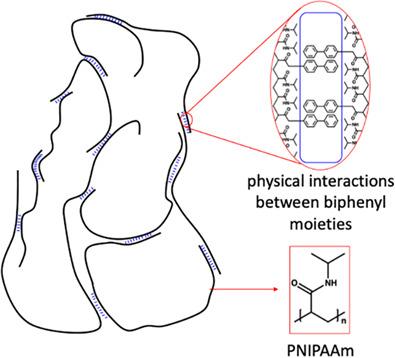Rishabh A Shah, Tyler Runge, Thomas W Ostertag, Shuo Tang, Thomas D Dziubla, J Zach Hilt
求助PDF
{"title":"由于分子间相互作用而产生物理交联的温度响应聚合物凝胶的研制","authors":"Rishabh A Shah, Tyler Runge, Thomas W Ostertag, Shuo Tang, Thomas D Dziubla, J Zach Hilt","doi":"10.1002/pi.6328","DOIUrl":null,"url":null,"abstract":"<p>Poly(<i>N</i>-isopropylacrylamide) was polymerized with comonomers containing a biphenyl moiety to create a unique thermoresponsive physically crosslinked system due to the presence of <i>π</i>–<i>π</i> interactions between the biphenyl moieties. The biphenyl monomers used were 2-phenylphenol monoacrylate (2PPMA) and 4-phenylphenol monoacrylate (4PPMA). These monomers were utilized to synthesize a set of polymers with biphenyl monomer (2PPMA/4PPMA) content from 2.5 to 7.5 mol% and with initiator concentrations of 0.1 and 1.0 wt%. The resulting polymers were characterized using various techniques, such as gel permeation chromatography (GPC), swelling studies and mechanical testing. A decrease in the average molecular weight of the polymers due to the increase in the concentration of initiator was confirmed from GPC results. Swelling studies confirmed the expected temperature-dependent swelling properties and explored the impact of the biphenyl comonomers. These studies indicated that with an increase in biphenyl comonomer content, the physical crosslinking increases which leads to a decrease in the swelling ratio. The results from the mechanical tests also indicate the effect of the concentration of biphenyl comonomers. These physically crosslinked polymeric systems with their unique properties have potential applications spanning environmental remediation/sensing, biomedicine, etc. © 2021 Society of Industrial Chemistry.</p>","PeriodicalId":20404,"journal":{"name":"Polymer International","volume":"71 3","pages":"292-300"},"PeriodicalIF":2.9000,"publicationDate":"2021-11-19","publicationTypes":"Journal Article","fieldsOfStudy":null,"isOpenAccess":false,"openAccessPdf":"","citationCount":"4","resultStr":"{\"title\":\"Development of temperature-responsive polymeric gels with physical crosslinking due to intermolecular 𝜋–𝜋 interactions\",\"authors\":\"Rishabh A Shah, Tyler Runge, Thomas W Ostertag, Shuo Tang, Thomas D Dziubla, J Zach Hilt\",\"doi\":\"10.1002/pi.6328\",\"DOIUrl\":null,\"url\":null,\"abstract\":\"<p>Poly(<i>N</i>-isopropylacrylamide) was polymerized with comonomers containing a biphenyl moiety to create a unique thermoresponsive physically crosslinked system due to the presence of <i>π</i>–<i>π</i> interactions between the biphenyl moieties. The biphenyl monomers used were 2-phenylphenol monoacrylate (2PPMA) and 4-phenylphenol monoacrylate (4PPMA). These monomers were utilized to synthesize a set of polymers with biphenyl monomer (2PPMA/4PPMA) content from 2.5 to 7.5 mol% and with initiator concentrations of 0.1 and 1.0 wt%. The resulting polymers were characterized using various techniques, such as gel permeation chromatography (GPC), swelling studies and mechanical testing. A decrease in the average molecular weight of the polymers due to the increase in the concentration of initiator was confirmed from GPC results. Swelling studies confirmed the expected temperature-dependent swelling properties and explored the impact of the biphenyl comonomers. These studies indicated that with an increase in biphenyl comonomer content, the physical crosslinking increases which leads to a decrease in the swelling ratio. The results from the mechanical tests also indicate the effect of the concentration of biphenyl comonomers. These physically crosslinked polymeric systems with their unique properties have potential applications spanning environmental remediation/sensing, biomedicine, etc. © 2021 Society of Industrial Chemistry.</p>\",\"PeriodicalId\":20404,\"journal\":{\"name\":\"Polymer International\",\"volume\":\"71 3\",\"pages\":\"292-300\"},\"PeriodicalIF\":2.9000,\"publicationDate\":\"2021-11-19\",\"publicationTypes\":\"Journal Article\",\"fieldsOfStudy\":null,\"isOpenAccess\":false,\"openAccessPdf\":\"\",\"citationCount\":\"4\",\"resultStr\":null,\"platform\":\"Semanticscholar\",\"paperid\":null,\"PeriodicalName\":\"Polymer International\",\"FirstCategoryId\":\"92\",\"ListUrlMain\":\"https://onlinelibrary.wiley.com/doi/10.1002/pi.6328\",\"RegionNum\":4,\"RegionCategory\":\"化学\",\"ArticlePicture\":[],\"TitleCN\":null,\"AbstractTextCN\":null,\"PMCID\":null,\"EPubDate\":\"\",\"PubModel\":\"\",\"JCR\":\"Q2\",\"JCRName\":\"POLYMER SCIENCE\",\"Score\":null,\"Total\":0}","platform":"Semanticscholar","paperid":null,"PeriodicalName":"Polymer International","FirstCategoryId":"92","ListUrlMain":"https://onlinelibrary.wiley.com/doi/10.1002/pi.6328","RegionNum":4,"RegionCategory":"化学","ArticlePicture":[],"TitleCN":null,"AbstractTextCN":null,"PMCID":null,"EPubDate":"","PubModel":"","JCR":"Q2","JCRName":"POLYMER SCIENCE","Score":null,"Total":0}
引用次数: 4
引用
批量引用


 求助内容:
求助内容: 应助结果提醒方式:
应助结果提醒方式:


